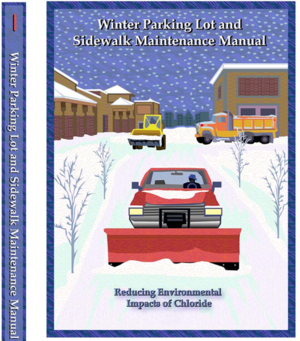
Difference between revisions of "Winter Parking Lot and Sidewalk Maintenance Manual"
m (Replaced content with "thumb|300px|alt=image of winter maintenance manual The Winter Parking Lot and Sidewalk Maintenance Manual delivers practical a...") Tag: Replaced |
|||
| (152 intermediate revisions by 2 users not shown) | |||
| Line 1: | Line 1: | ||
| − | = | + | [[file:Winter maintenance manual logo.png|thumb|300px|alt=image of winter maintenance manual]] |
| − | + | The Winter Parking Lot and Sidewalk Maintenance Manual delivers practical advice to those managing parking lots and sidewalks. The manual helps to make proactive, cost-effective, environmentally conscious choices in winter parking lot and sidewalk management. This knowledge will provide the opportunity to become a leader in the industry by operating more efficiently and reducing environmental impacts. A single approach will not work for the range of conditions Minnesota experiences; different strategies are needed for different regions and different weather conditions. We encourage continuing to test, document, and refine the practices from this manual. | |
| − | + | The manual was developed in 2006 and underwent revisions in 2010 and 2015. The information in the manual has been reorganized and reformatted for inclusion in the Minnesota Stormwater Manual. As a result, the manual was organized into several pages that address specific topics and are linked to each other. These pages can also be viewed as a single page. The 2015 Winter Parking Lot and Sidewalk Maintenance Manual can also be accessed as a [https://www.pca.state.mn.us/sites/default/files/parkinglotmanual.pdf pdf document]. | |
| − | + | [[Acknowledgements for Winter Parking Lot and Sidewalk Maintenance Manual|Acknowledgements]] | |
| − | + | *[[Background information for winter parking lot and sidewalk maintenance]] | |
| + | *[[Preparing for winter operations for winter parking lot and sidewalk maintenance]] | ||
| + | *[[Keeping surfaces clear for winter parking lot and sidewalk maintenance]] | ||
| + | *[[Evaluating the effectiveness for winter parking lot and sidewalk maintenance]] | ||
| + | *[[Environmental tips for winter parking lot and sidewalk maintenance]] | ||
| + | *[[Cost savings tips for winter parking lot and sidewalk maintenance]] | ||
| + | *[[Results and evaluation for winter parking lot and sidewalk maintenance]] | ||
| + | *[[Material conversions for winter parking lot and sidewalk maintenance]] | ||
| + | *[[References for winter parking lot and sidewalk maintenance]] | ||
| + | *[[Additional resources and links to websites for winter parking lot and sidewalk maintenance]] | ||
| − | + | To view the above pages as a single document, [[Winter parking lot and sidewalk maintenance combined|click here]] | |
| − | + | [[Category:Level 2 - Management/Winter management]] | |
| − | + | [[Category:Level 2 - Pollutants/Chloride]] | |
| − | |||
| − | |||
| − | |||
| − | |||
| − | |||
| − | |||
| − | |||
| − | |||
| − | |||
| − | |||
| − | |||
| − | |||
| − | |||
| − | [[ | ||
| − | |||
| − | |||
| − | |||
| − | |||
| − | [[ | ||
| − | |||
| − | |||
| − | |||
| − | |||
| − | |||
| − | |||
| − | |||
| − | |||
| − | |||
| − | |||
| − | |||
| − | |||
| − | |||
| − | |||
| − | |||
| − | |||
| − | |||
| − | |||
| − | |||
Latest revision as of 15:12, 23 November 2022
The Winter Parking Lot and Sidewalk Maintenance Manual delivers practical advice to those managing parking lots and sidewalks. The manual helps to make proactive, cost-effective, environmentally conscious choices in winter parking lot and sidewalk management. This knowledge will provide the opportunity to become a leader in the industry by operating more efficiently and reducing environmental impacts. A single approach will not work for the range of conditions Minnesota experiences; different strategies are needed for different regions and different weather conditions. We encourage continuing to test, document, and refine the practices from this manual.
The manual was developed in 2006 and underwent revisions in 2010 and 2015. The information in the manual has been reorganized and reformatted for inclusion in the Minnesota Stormwater Manual. As a result, the manual was organized into several pages that address specific topics and are linked to each other. These pages can also be viewed as a single page. The 2015 Winter Parking Lot and Sidewalk Maintenance Manual can also be accessed as a pdf document.
- Background information for winter parking lot and sidewalk maintenance
- Preparing for winter operations for winter parking lot and sidewalk maintenance
- Keeping surfaces clear for winter parking lot and sidewalk maintenance
- Evaluating the effectiveness for winter parking lot and sidewalk maintenance
- Environmental tips for winter parking lot and sidewalk maintenance
- Cost savings tips for winter parking lot and sidewalk maintenance
- Results and evaluation for winter parking lot and sidewalk maintenance
- Material conversions for winter parking lot and sidewalk maintenance
- References for winter parking lot and sidewalk maintenance
- Additional resources and links to websites for winter parking lot and sidewalk maintenance
To view the above pages as a single document, click here
This page was last edited on 23 November 2022, at 15:12.
